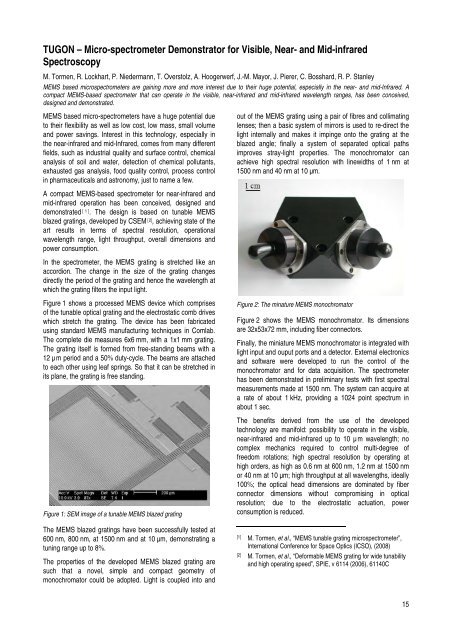CSEM Scientific and Technical Report 2008
CSEM Scientific and Technical Report 2008
CSEM Scientific and Technical Report 2008
You also want an ePaper? Increase the reach of your titles
YUMPU automatically turns print PDFs into web optimized ePapers that Google loves.
TUGON – Micro-spectrometer Demonstrator for Visible, Near- <strong>and</strong> Mid-infrared<br />
Spectroscopy<br />
M. Tormen, R. Lockhart, P. Niedermann, T. Overstolz, A. Hoogerwerf, J.-M. Mayor, J. Pierer, C. Bosshard, R. P. Stanley<br />
MEMS based microspectrometers are gaining more <strong>and</strong> more interest due to their huge potential, especially in the near- <strong>and</strong> mid-Infrared. A<br />
compact MEMS-based spectrometer that can operate in the visible, near-infrared <strong>and</strong> mid-infrared wavelength ranges, has been conceived,<br />
designed <strong>and</strong> demonstrated.<br />
MEMS based micro-spectrometers have a huge potential due<br />
to their flexibility as well as low cost, low mass, small volume<br />
<strong>and</strong> power savings. Interest in this technology, especially in<br />
the near-infrared <strong>and</strong> mid-Infrared, comes from many different<br />
fields, such as industrial quality <strong>and</strong> surface control, chemical<br />
analysis of soil <strong>and</strong> water, detection of chemical pollutants,<br />
exhausted gas analysis, food quality control, process control<br />
in pharmaceuticals <strong>and</strong> astronomy, just to name a few.<br />
A compact MEMS-based spectrometer for near-infrared <strong>and</strong><br />
mid-infrared operation has been conceived, designed <strong>and</strong><br />
demonstrated [ 1] . The design is based on tunable MEMS<br />
blazed gratings, developed by <strong>CSEM</strong> [2] , achieving state of the<br />
art results in terms of spectral resolution, operational<br />
wavelength range, light throughput, overall dimensions <strong>and</strong><br />
power consumption.<br />
In the spectrometer, the MEMS grating is stretched like an<br />
accordion. The change in the size of the grating changes<br />
directly the period of the grating <strong>and</strong> hence the wavelength at<br />
which the grating filters the input light.<br />
Figure 1 shows a processed MEMS device which comprises<br />
of the tunable optical grating <strong>and</strong> the electrostatic comb drives<br />
which stretch the grating. The device has been fabricated<br />
using st<strong>and</strong>ard MEMS manufacturing techniques in Comlab.<br />
The complete die measures 6x6 mm, with a 1x1 mm grating.<br />
The grating itself is formed from free-st<strong>and</strong>ing beams with a<br />
12 µm period <strong>and</strong> a 50% duty-cycle. The beams are attached<br />
to each other using leaf springs. So that it can be stretched in<br />
its plane, the grating is free st<strong>and</strong>ing.<br />
Figure 1: SEM image of a tunable MEMS blazed grating<br />
The MEMS blazed gratings have been successfully tested at<br />
600 nm, 800 nm, at 1500 nm <strong>and</strong> at 10 μm, demonstrating a<br />
tuning range up to 8%.<br />
The properties of the developed MEMS blazed grating are<br />
such that a novel, simple <strong>and</strong> compact geometry of<br />
monochromator could be adopted. Light is coupled into <strong>and</strong><br />
out of the MEMS grating using a pair of fibres <strong>and</strong> collimating<br />
lenses; then a basic system of mirrors is used to re-direct the<br />
light internally <strong>and</strong> makes it impinge onto the grating at the<br />
blazed angle; finally a system of separated optical paths<br />
improves stray-light properties. The monochromator can<br />
achieve high spectral resolution with linewidths of 1 nm at<br />
1500 nm <strong>and</strong> 40 nm at 10 μm.<br />
Figure 2: The minature MEMS monochromator<br />
Figure 2 shows the MEMS monochromator. Its dimensions<br />
are 32x53x72 mm, including fiber connectors.<br />
Finally, the miniature MEMS monochromator is integrated with<br />
light input <strong>and</strong> ouput ports <strong>and</strong> a detector. External electronics<br />
<strong>and</strong> software were developed to run the control of the<br />
monochromator <strong>and</strong> for data acquisition. The spectrometer<br />
has been demonstrated in preliminary tests with first spectral<br />
measurements made at 1500 nm. The system can acquire at<br />
a rate of about 1 kHz, providing a 1024 point spectrum in<br />
about 1 sec.<br />
The benefits derived from the use of the developed<br />
technology are manifold: possibility to operate in the visible,<br />
near-infrared <strong>and</strong> mid-infrared up to 10 µm wavelength; no<br />
complex mechanics required to control multi-degree of<br />
freedom rotations; high spectral resolution by operating at<br />
high orders, as high as 0.6 nm at 600 nm, 1.2 nm at 1500 nm<br />
or 40 nm at 10 μm; high throughput at all wavelengths, ideally<br />
100%; the optical head dimensions are dominated by fiber<br />
connector dimensions without compromising in optical<br />
resolution; due to the electrostatic actuation, power<br />
consumption is reduced.<br />
[1] M. Tormen, et al., “MEMS tunable grating microspectrometer”,<br />
International Conference for Space Optics (ICSO), (<strong>2008</strong>)<br />
[2] M. Tormen, et al., “Deformable MEMS grating for wide tunability<br />
<strong>and</strong> high operating speed”, SPIE, v 6114 (2006), 61140C<br />
15








